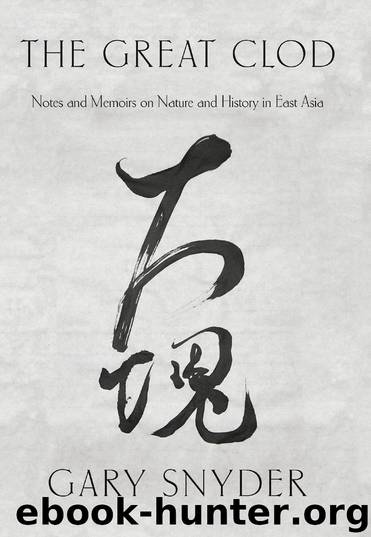The Great Clod by Gary Snyder

Author:Gary Snyder
Language: eng
Format: epub
ISBN: 9781619026636
Publisher: Counterpoint
Published: 2016-04-22T16:00:00+00:00
Walls Within Walls
High population, deforestation, a cash economy, and tribal nomad horsemen bring a partial end to one of the peak urban cultures: Sung Dynasty China.
CITY WALLS
Dwelling within walls-within-walls was normal for the Chinese people of the plains and valleys. In the Former-Han dynasty there were an estimated 37,844 walled settlements of various sizes, with perhaps 60 million people living behind them.a Walls are a striking part of the Chinese landscape even today, the gently slanted stone walls of a provincial capital, broken by occasional towers that project two or three stories higher yet, rising through the mist fronting a river or lake, or mirrored in half-flooded fields.
Yi-fu Tuan. China (Chicago: Aldine, 1970).
The early Neolithic settlements of the Yang-shao type had no walls. Instead they were surrounded by ditches or moats about 15 feet wide and deep. These were probably to keep out animals; deer are notorious nibblers on orchards and vegetable gardens. Digs of Yang-shao settlements have turned up few, if any, fighting weapons. Lung-shan type settlements of the later Neolithic have tamped-earth fortifications and weapons.b
Kwang-chih Chang. The Archeology of Ancient China (New Haven: Yale University Press, 1977) p. 152
Around the fifth century BC, as the Eastern Chou dynasty slipped toward the era of “Warring States,” the basic style of walled city began to take shape.
The type consisted of at least three contrasting spatial units: a small enclosure which was the aristocratic and administrative centre, mixed (in early times) with dependent tradesmen and artisans; industrial and commercial quarters, with residences, in a large enclosure; farmlands immediately beyond the city walls. In the warring states period sometimes three successive ramparts were built, suggesting a need to extend protection to increasingly large areas of commercial activity. Another change lay in the strengthening of the outer walls at the expense of the walls of the inner citadel, which were allowed to go into decay.c
Tuan, p. 67
The city of Hsia-tu, in the state of Yen, is estimated to have been ten square miles within the walls. There were also the “great walls” to keep out the northern nomad tribesmen, the walls originally built by the states of Ch’in, Yen, and Chao. When Ch’in became the first all-China empire, 221 BC, it joined together previous sections to make a more continuous barrier.
The dominant element of the Han dynasty town-scape was the wall. It separated a settlement from the outlying fields, and by creating an enclosure facilitated the regimentation of life within . . . it had the character of a succession of walled-in rectangles. There was the town wall with gates on the four sides. Within the wall the settlement was partitioned into a number of wards. Ch’ang-an itself had as many as 160 wards. Streets separated the wards, which were in turn surrounded by walls. Each ward had only one gate opening to the street during Han times and contained up to one hundred households, each of which was again surrounded by a wall. The inhabitants, to get out of town, would thus
Download
This site does not store any files on its server. We only index and link to content provided by other sites. Please contact the content providers to delete copyright contents if any and email us, we'll remove relevant links or contents immediately.
| Archaeology | Essays |
| Historical Geography | Historical Maps |
| Historiography | Reference |
| Study & Teaching |
Underground: A Human History of the Worlds Beneath Our Feet by Will Hunt(12049)
Sapiens by Yuval Noah Harari(5316)
Navigation and Map Reading by K Andrew(5128)
The Sympathizer by Viet Thanh Nguyen(4334)
Barron's AP Biology by Goldberg M.S. Deborah T(4120)
5 Steps to a 5 AP U.S. History, 2010-2011 Edition (5 Steps to a 5 on the Advanced Placement Examinations Series) by Armstrong Stephen(3704)
Three Women by Lisa Taddeo(3386)
Water by Ian Miller(3150)
The Comedians: Drunks, Thieves, Scoundrels, and the History of American Comedy by Nesteroff Kliph(3054)
Drugs Unlimited by Mike Power(2563)
A Short History of Drunkenness by Forsyth Mark(2252)
DarkMarket by Misha Glenny(2193)
The House of Government by Slezkine Yuri(2176)
And the Band Played On by Randy Shilts(2162)
The Library Book by Susan Orlean(2048)
Revived (Cat Patrick) by Cat Patrick(1971)
The Woman Who Smashed Codes by Jason Fagone(1939)
Birth by Tina Cassidy(1884)
The Absolutely True Diary of a Part-Time Indian by Sherman Alexie(1875)
